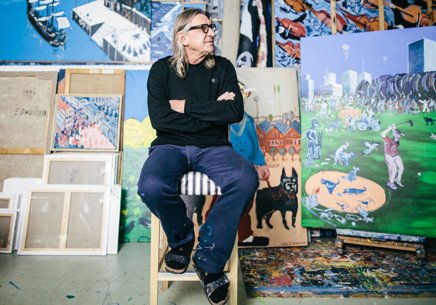
This exhibition of works by Edward Dwurnik in the National Museum in Kraków included more than 100 paintings and drawings by the artist, including several cycles of his paintings from the late 1960s to the first decades of the 21st century, depicting such themes as Athletes, Workers, Warsaw, Hitchhiking trips, Passion, and The cross. An important part of this exhibition comprises rarely-exhibited drawings and collages created by Dwurnik to parallel his paintings (the cycles "Wall", "One day", "My heroes", "In the shadow of the building", "Workers").
This presentation of works created over more than 40 years was not a complete retrospective. The exhibition have given us an extensive overview of works executed by the artist over many years. The selection of paintings and drawings was subjective; however, they have been brought together with the idea of providing a broad approximation of Dwurnik’s oeuvre and provoking his viewers to explore it further on their own.
"Madness", the title of the exhibition, refers to a current concept with a highly ambiguous meaning –as ambiguous, in fact, as the artist’s paintings. On one hand, the term is a synonym for madness, but on the other, for something extraordinary, amazing and wonderful. ‘It’s sheer insanity!’ is an everyday phrase, used whenever we see someone doing something ridiculous, or who appears to be out of his mind. Since the most important issue in Dwurnik’s work is the Polish civilization surrounding it, it seems to us that the term also describes the nature of the world represented in the artist’s paintings. Moreover, ‘insane’ might denote the artist’s output itself, as for years he turned out picture after picture like a madman; his current oeuvre numbers more than 4,000 works.
Dwurnik’s figurative paintings seem readily accessible. The artist consciously produces pictures accepted by institutions and the commercial art market as ‘understandable’, reaching not only the masses, but also the walls of pretentious amateur lovers of contemporary art. Today, we get the impression that everyone knows Dwurnik. But not completely! Dwurnik has become a kind of brand name, a name that says little about Dwurnik himself. Therefore, today it’s well worth getting acquainted with his oeuvre of many years.
The works presented at the National Museum in Kraków have been arranged chronologically, thanks to which we can track the formal transitions, along with the continuity of certain themes, to be found in the artist’s work over a forty-year period. This is facilitated by the practice of dating works by year, month, and even day.
While viewing the show, attention should be paid to the relationship between Dwurnik’s work and Polish reality of the last four decades. Particularly helpful are the suggestive titles the artist gave his works, as well as the biographical sketch which can be found in the exhibition space, in the folder, and in the exhibition catalogue, containing important information about Dwurnik’s work, as well as about social, political and artistic events affording an essential context for the interpretation of his art. It is also worth reading the articles included in the catalogue, by Anna Markowska and Kamila Wielebska, analysing Dwurnik’s work from methodological contemporary perspectives.
Curator: Dominik Kuryłek
Coordinator: Beata Foremna
Exhibition design: Malwina Antoniszczak, Monika Bielak
Graphic design: Parastudio
The honorary patron of the exhibit is Minister of Culture and National Heritage Bogdan Zdrojewski.
Dwurnik, Main Bulding, polish painter, polish art, national museum krakow, Poland, Dominik Kuryłek,
MNK The Main Building
al. 3 Maja 1- Monday: closed
- Tuesday - Sunday: 10.00-18.00